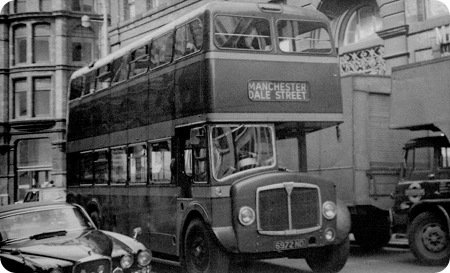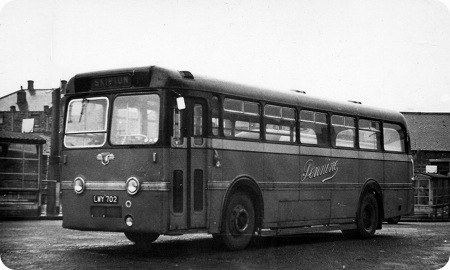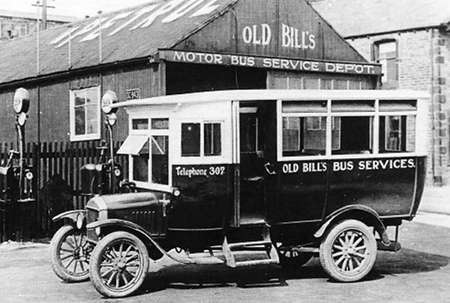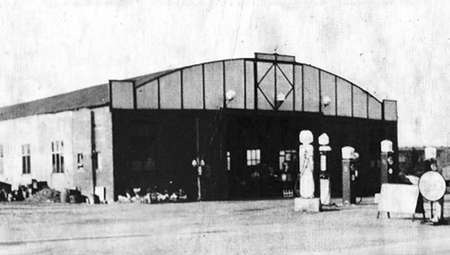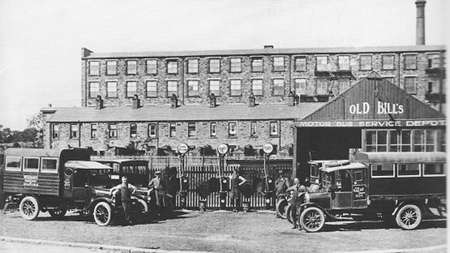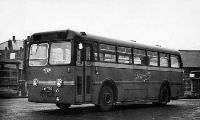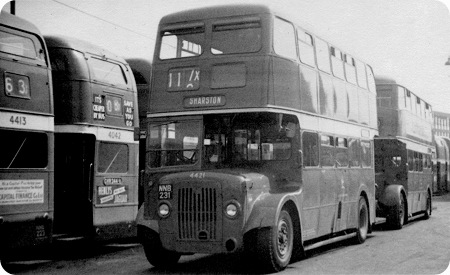
Photograph by ‘unknown’ if you took this photo please go to the copyright page.
Manchester Corporation
1954
Daimler CVG6
Metro Cammell H32/28R
In 1965 Manchester had 398 Daimler CVs all rear entrance. Out of the 398 158 of them had the 7·0 litre 5 cylinder Gardner 5LW diesel engine the rest having the more powerful 8·4 litres, six cylinder Gardner 6LW. They also had one CLG5 registration PND 490 fleet number 4490 which was delivered in 1955 it must of been one of the last of the CL models as production ceased in 1955. The CL was a lightweight version of the CV it was in fact 10cwt lighter but most of its weight saving features were either available or incorporated into the CV so in 1955 it was the end of the CL. The last five in the last batch of front engined Daimlers delivered to Manchester were CCG6s the middle C stood for the Constant mesh gearbox that was fitted, this made a total of 404 it would of been 405 but for some reason GVR 336 – 4034 had been withdrawn, any one know the reason why? Along with the Daimler CVs Manchester also had 160 Crossley DD42s and 570 Leyland Titans all of which were rear entrance vehicles, But at the same time rear engined front entrance Atlanteans and Fleetlines were being bought in large quantities, so the switch to front entrance vehicles did not involve a front engined vehicle. I thought that was a little strange. So I checked out Liverpool corporation they also switched the same way, though they did have one front entrance Regent V which was classed as experimental. On checking Leeds City Transport I think they also only had five front entrance front engined vehicles Daimler CVG6LX-30s which it would appear were bought for one specific route anyway. So the switch from front engined rear entrance to rear engined front entrance double deckers does not appear to be that strange after all, it may have something to do with the size of the fleet!!!
In 1971 I went up to music college and CVG6s, like the one in the picture, were still very much around. They trundled around the flat-lands of South Manchester and the Cheshire plain with no problem, despite their age – particularly on the 44 to Ringway Airport (Manchester International now) and 46 to Styall (just short of Wilmslow).
They were not as sprightly as the PD2s, nor especially the North Western Renowns, which charged down the Wilmslow Road and Palatine Road. I read recently somewhere that, despite their manual boxes, many drivers preferred the PD2s.
The CCG6s were "foisted" on both Manchester and Salford Corporations in equal small numbers. They had the Guy "crash" box (at a time when Daimler and Guy had been brought together under Jaguar ownership) and were hated as much as the Leylands were revered. They were, however, offered at a knock-down price to sweeten the pill. [Pity, because they had the musical quality beloved of enthusiasts on contemporary Guy Arabs.]
I cannot remember whether it was here on this site, or elsewhere, that I recently read that putting a forward entrance on a front engined chassis caused an unforeseen weakness in body structure not evident with the entrance behind the rear axle. The Liverpool bus mentioned about was part of their experimental fleet and Sheffield had only around 30 forward entrance vehicles. I seem to think the Leeds buses were for the 72 and one of them survives in preservation.
Engineers actually knew what they were talking about and they would talk to each other. Often gricers only find out with the benefit of historical hindsight. [It took nearly fifteen years for Leyland to get the Atlantean right with the AN68! That was probably another, better reason, to stick with the "old".]
David Oldfield
The five Leeds forward entrance Daimlers were originally intended for and were employed on the 72 service to Bradford, jointly operated with the latter Corporation, where they were of a similar layout to the blue vehicles on the route. When Bradford went "rear engined" the Leeds buses were firstly used on the services to Garforth, Kippax and Ledston Luck which had been taken over from Kippax and District (Wallace Arnold). Later the Leeds five saw more general use, although predominantly on the services from Moortown and Meanwood via City to Morley. Immediately after the formation of the WYPTE all five were transferred to Huddersfield (Kirklees) where they "fitted in better" and I took a picture of one in Longroyd Bridge Depot boasting the idyllic destination "Salendine Nook." One of the five is indeed in preservation but I believe not yet fully restored.
Chris Youhill
The 5 Leeds front entrance Daimlers were CVG6LX-30 models and were bought for the joint 72 Leeds Bradford service, Bradford were using AEC Regent Vs with MCW bodywork at that time. The Leeds buses were later used on the Garforth services. Following the advent of the PTE they moved to Huddersfield
Chris Hough
Chris Youhill is normally reliable in everything he says, so maybe there are two! The Leeds Daimler I refer to was, until recently, running – resplendent in Huddesfield livery – in Steve Morris’s preserved fleet at Quantock Motor Service. [I drove for last year’s Minehead event where it performed all day.] I think it is one of those which was up for sale because of his downsizing.
David Oldfield
Although Manchester 4490 was often described as a CLG5, later wisdom has it that this was a model that never actually went into production. Either one or two prototypes were completed (in Alan Townsin’s book on post-war Daimlers, ‘The Best of British Buses No 11’, the text appears to conflict with the photograph captions on this point), but operators were not happy to accept all of the features. As a result, a number of experimental lightweight CVs were built with some but not all of the features of the CL prototypes, and it appears than 4490 was one of these.
Peter Williamson
Thank you indeed to David Oldfield for that most welcome piece of news, as I’m almost certain that the "Steve Morris" one of which I was unaware is not the one I mean. The one that I mentioned has fairly recently been acquired by a Leeds preservationist (a friend of mine who I see very little lately) but I’m pretty certain it had been a playbus fairly near here. I shall ring him at a civilised hour in the morning and find out for sure. So all being well this will be a rise from 20% to 40% in the members of this interesting batch still around. It is to my lasting regret that I was done out of a drive in one of these by a "photo finish." I was spare one day at the LCT central Leeds Sovereign Street Depot (5 minutes walk from town) and the Inspector told me to go quickly to the Corn Exchange where a bus for Morley was waiting with a full load as the relief driver had not turned up. It was "one of the famous five" and I was thrilled, but I was beaten to the cab door by a short head when the absentee turned up. I was just formulating a plan to offer him £10 to disappear for a few minutes when he set off leaving me in the middle of the road like a lemon. So I never did have a drive in a front entrance CVG6LX. Oh, I did once move one around the City centre, empty, when it was out of service for a staff shortage, but that’s not quite the same thing as a live service journey is it ??
Chris Youhill
A follow on from Chris
Excellent news this morning – two of the famous five are still with us !! The one my friend owned – 574 – was sold by him some time ago to a work colleague who was eventually unable to complete it. It is now safe in the hands of the excellent Aire Valley Group at Keighley, who will no doubt fully restore it to a very high standard. The one in Huddersfiled livery – 572 – has indeed been offered for sale and we don’t know yet where it is but presumably it will remain pristine and active in a new owner’s care.
This batch statistic must surely give a whole new meaning to the term "proportional representation.
Chris Youhill
Glad to bring the tidings and that there are now two!
David Oldfield
I read with interest the comments about 5 cyl Daimlers on Princess Pkwy from Northenden (Sharston) Depot and the fact that 5 cyls were not used on the road for all day services due to their lack of power.
This is strange as the post war batch of Damilers (4000-99) many of which were included in the Northenden allocation and 4510-4549 (many of which were included in Northenden) were used in all day service for many years.
Indeed the 45xx were mainly used on the Limited Stop services such as the 101 and 103 and I remember how drivers would throw them round the roundabout at Wythenshawe Road, the buses leaning over at quite an angle.
That these 5 cyl buses were short on power is not in doubt. The performance of the early post war batch was very poor but then the Leyland PD1 was also not a very good performer with its 7.4 litre engine.
However fuel consumption on such buses was rather better than that of modern buses!
Malcolm Crowe
While puzzling over the reluctance of certain operators to adopt front entrance bodywork on halfcabs, what about the strange reluctance in Manchester to adopt 30ft halfcabs? Leeds, Bradford, Huddersfield and Halifax all adopted them very quickly, London had its ugly "cut & shut" RML Routemasters, but Manchester, along with Ashton, SHMD and Stockport stuck with the 27ft length to the end (apart from Stockport’s very last batch) even though others in the conurbation experimented with bigger buses. Hasn’t it always seemed odd that Manchester went so quickly from being a city of small buses to one infested with the vast Mancunians?
David Jones
The change from ancient to modern isn’t quite that surprising since it coincided with the arrival of Ralph Bennett from Bolton and a new boss will always make his/her mark on an organisation.
As for PD2/PD3. I have never been an operator, but I once read that the PD3 was never considered to be quite up to PD2 standard. [Could have been power to weight ratio or the strain of extending drive gear a further 3′.] PD2s were always regarded as a quality product and in theory the only difference with the PD3 was the length. PD2s in Manchester were highly regarded by everyone and were more than man enough for the job in hilly North Manchester. In mountainous Sheffield, PD3s could make heavy work of the job!
David Oldfield
Halifax may have adopted the thirty-foot PD3 very quickly, but notably they reverted to the shorter PD2 for many later deliveries. Having seen some of the termini it is not entirely surprising, but the number of PD2s bought later is more than would be warranted for this reason. I suspect performance on gradients also had something to do with it, there are certainly plenty of those in Halifax!
Although it’s hard now to think of them that way, 30 foot long buses were once bigger than normal and the extra length of such buses would have caused problems in busy termini such as Manchester Piccadilly if there had been large numbers in the fleet. Obviously that issue was eventually addressed but looking at the current congestion in Piccadilly Gardens is it easy to see how critical this issue can be.
David Beilby
Unlike many operators, Manchester specified maximum capacity (65) for its 27-footers, and could only have got another 8 in a 30-footer. You then have to consider industrial relations, which weren’t easy in Manchester and were negotiated on a garage-by-garage basis. Conductors would have either objected to the extra work or wanted more money, so it probably wasn’t worth the hassle.
Eventually 10 Atlanteans were purchased, with 12 extra seats and the advantage of the driver looking after the platform. Even these sat around for ages while the management and the Northenden union did battle (Northenden had the most difficult union and was chosen deliberately, on the basis that once that nut was cracked, the rest would follow more easily).
I would also make the point that by the time Ralph Bennett arrived in 1965, Manchester had already abandoned half cabs and been buying Fleetlines steadily for 3 years. All subsequent deckers were 30 feet long (including the first Mancunians) until the very end of 1968 when the first 33-footers arrived.
Peter Williamson
I was a driver in the mid-late 60’s (Birchfields road) and remember seeing a photograph of a double decker standing on eggs. Does anybody have a copy of this? At that time, there was an ‘old bus restoration’ shop in one of the disused entrances.
Peter Dorricott
04/10/11 – 17:17
It’s not strictly true that only Stockport’s last batch were PD3’s. In fact all new double deck vehicles after 1967 were PD3’s which gave a total of 27 in all. There’s a school of thought that the Transport Dept only ordered these because PD2’s were no longer available. The PD3’s did not handle as well as the PD2’s, the steering was exceptionally heavy whilst the performance was no great shakes on Stockport’s hills.
Chris Flynn
04/10/11 – 21:11
Re the debate about front entrance half cabs. I always think that it was peculiar that Grimsby- Cleethorpes specified hinged cab doors on their Daimler CVG/Roe and on the AEC Regent Vs/Roe when the general norm was for sliding doors. Surely with the latter buses could be parked up closer together.
Philip Carlton
06/10/11 – 07:25
It cannot be true that Stockport only ordered PD3s because the PD2 was no longer available – unless Leyland planned to withdraw the PD2 and then changed its mind. According to //www.buslistsontheweb.co.uk/ the last PD2s were delivered to Darwen in April 1969, two months after Stockport received its final PD3s.
Peter Williamson
01/11/11 – 06:40
Manchester Corporation Daimler CVG5 No 4034 referred to above in original text was irreparably damaged following a collision with a lorry in 1951.
Lorry emerged from Raby Street and knocked the bus over.
(Info extracted from "The Manchester Bus" by Michael Eyre & Chris Heaps)
Andrew Scholes
12/04/12 – 06:13
I was a conductor, then driver from 1959 to 1978 at Birchfields Rd. Depot. I well remember some of the ‘workings out’ we got on Circular (53 Cheetham Hill to Brooks’s Bar/Old Trafford) especially if we had a Princess Rd. Daimler in front! I remember too the ‘crash box’ Daimlers, which were ok to drive on the quiet routes, 85, Chorlton/Albert Sq., or the 20, Chorlton St./Woodford. But they were no match for other Daimlers, and particularly Leylands in the fleet. 3550, although well worn, was a favourite! I particularly enjoyed driving the few 3400’s we had at Birch.
I read with interest, Peter Dorricot’s question re the Double Decker standing on eggs. Sorry I can’t offer any info on that, but I do remember the name.
Unfortunately, so many years on, I cannot put a face to the name.
Those were good days behind the wheel with a conductor, not so great as one man operation took over. But that was progress – I suppose!
Bill Parkinson
28/09/12 – 07:56
The 4400 batch of CVG6s were unique to Manchester. The body was a stopgap between the MCW Phoenix, of which both Manchester and Salford had large batches and were very long lived, and the Orion.
The close co-operation between MCTD and MCW led to yet another long lived batch. Delivered from Nov 1953 to July 1954 they survived well into SELNEC days, at least one receiving SELNEC livery, most attaining 19-20 years and many being in all day service all their lives.
At least one example inherited a complete rear axle from one of the previous Phoenix bodied Daimlers and the batch had the "distinction" of having one of its number selected as the trial bus for the spray booth scheme which eliminated the cream surrounds of the upper deck windows.
Phil Blinkhorn
29/09/12 – 07:34
To pick up David Beilby’s comment on the Halifax PD2 versus PD3 question, it is true that the later Halifax Titans were all PD2s. The restricted terminal working arrangements at some of the outer destinations was only part of the story. As a Traffic Clerk in Halifax in the mid 1960s, I regularly covered the second half of late turns on the road, and my preference was for the 48/49 Brighouse – Hebden Bridge routes, which were the regular haunt of the 30 footers, PD3 and Regent V. The PD3 was certainly less lively than its shorter stablemate, though the very low first gear would eventually get it up even the stiffest Halifax gradient. I can state from personal experience that the serious shortcoming of the PD3 was its distressing reluctance to stop – it would seem that the braking system was identical to that of the lighter PD2. The synchromesh Regent V (in my view, a pretty unsophisticated piece of machinery – sorry David O), whilst less than ideal in the braking department, was decidedly more reassuring when it came to stopping the thing. The first double deck bus in my experience that had really decent brakes was the Dennis Loline.
Roger Cox
29/09/12 – 12:39
So? The syncro Regent was an unsophisticated machine – especially by today’s standards – but it didn’t make it a bad bus, and AEC brakes were always better than Leylands.
David Oldfield
29/09/12 – 12:39
I was interested to read Roger Cox’s comments about the Halifax’s PD3’s brakes versus the PD2’s. I too worked as a Traffic Clerk at Halifax – though in the early 1970’s – and like him I regularly worked the second half of late turns driving in the evenings, and nearly all day on Saturdays. The 48/49 had been split up into separate routes and converted to OMO just before I started, and since I only did Crew Driving at the time I rarely covered those sections, but worked fairly randomly on all the crew routes. Later I transferred to Driver and have done that until the present time – although now only part-time in semi-retirement. So I drove them on a regular basis until the last one was withdrawn.
I must say that although the PD3’s naturally felt a bit heavier to drive than the PD2’s and were a bit harder work to get going, I never really found their brakes to be any less adequate. However, when WYPTE took over we soon afterwards received quite a number of ex-Huddersfield PD3A/2’s with Roe bodies, and these certainly could exhibit a ‘distressing reluctance to stop’, and I had quite a few heart-stopping experiences with some of them. They also used to squeal really loudly.
A number of the original Halifax Regent V’s had already been withdrawn by then, and the remaining ones were rather tired and hard work to drive, giving the impression of being not as durable as the Leylands. There were however three ex-Hebble examples and rather unexpectedly these were considerably better and were really nice to drive. In my experience (I also later drove several ex-Bradford ones in service, and others in preservation) Regent V’s could vary tremendously from one operator to another according to their specification.
Back to the original topic – Manchester CVG6’s. Before I was at Halifax I was a Schedules Clerk at SELNEC Central, based at the former Salford depot at Frederick Road. Some of these 44xx series Daimlers had been allocated there and I rode on them on a number of occasions. Though like most CVG6’s they were steady plodders (I hate to think what the CVG5 was like), they were highly regarded for their total reliability, and to me seemed to be really solid buses for their age.
John Stringer
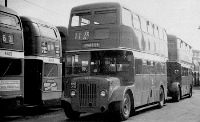 Vehicle reminder shot for this posting
Vehicle reminder shot for this posting
21/02/14 – 06:50
I came across the 2012 correspondence re Manchester’s old Daimler CVG5 and -6 buses and I can remember their presence in the south of the city. The 4000-99 batch were always on the 101 service in the early ’60s and also seemed to do the rush-hour extras and school contract work. It seems that the body-weight/engine size combination meant that they could only work ‘flat’ routes such as those around Wythenshawe, but it was a surprise to come across a colour image of one of them running on one of the city’s sink estates-built at the end of a long climb from the city-centre-against a background of houses that were built ca. 1968. The bus had good-looking paintwork and was carrying blinds for a local service (the ‘211’ [now the 201]) but was ‘off-route’ and the number-blinds had the non-standard ‘2-11′ mix instead of the Hyde Road ’21-1’ (based on the former trolley-bus route-number sequence ‘210’ to ‘219’), so it seems to have been pulled from the scrap-line for a special photo-session. It’s hard to believe that the Hyde Road management would condone the release of even a scrap bus for anything as frivolous as this, and the CVG5, given its alleged poor performance would never have worked the area (which only saw the odd, end-of-life, Crossley (2078 was one example) being given an optimistic morning duty that would give it a mostly-downhill trip carrying a full load of passengers. These Daimlers had/have been special to local bus anoraks because of their peculiar exhaust sound-effects, and it’s possible that the picture had some connection with a last-minute attempt to preserve one of them. Does anyone know any more?
John Hardman
